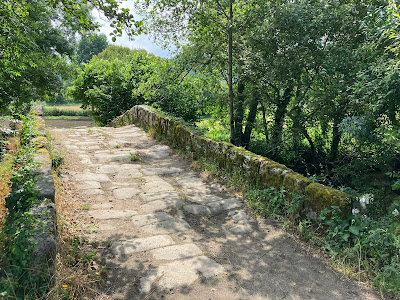 |
| The Cathedral at Tui |
A Tale of Two Pastas
The one, preparéd with indecent haste:
Rotini formed the base. No sauce,
But chunks of hard boiled egg were tossed on top,
All garnishéd with tuna from the can,
A sorry dish, and shunned by every man.
The other, vegetarian, and simple fare,
With sauce ambrosial — a spághetti
Prepared for pilgrim guests with special care
It was indeed, une assiette si bonne
For words, I search in vain the lexicon.
At the Quinta Estrada Romana, the meal was excellent. It couldn’t have been simpler, but they were working on the sauce during the afternoon. Everyone busied themselves and helped, and made a donation at the end.
I am full of admiration for the walking wounded. Yesterday, I mentioned Keith from Toronto who had wisely taken a taxi over the mountain. Not so, a Czech lady whose name I never did at catch.
In the other room at the Albergue O Inconforto, there were three people from the Czech republic. I noticed that one of the women was hobbling very badly. The other two passed me on the climb yesterday, and I ran into them again at coffee on the other side — of the mountain, that is — and they explained that their companion was making her way slowly behind them. We ended up at the same albergue, but that their companion was stopping nine kms back. But no, a couple of hours later she arrived. Unfortunately, she was in a dorm two flights of stairs up. She had to pull herself up by her arms on the railings. She was always cheerful, laughing about her injury, and I passed her for the last time, this morning, a kilometre from the hostel. She was almost literally moving at a snail’s pace, inching herself along. The three were going to stop at Tui, the Spanish town just across the border, about 11 km on. I hoped she would make it.
At noon, Tui was deserted. I remembered that last time, when I was here in the morning, the town was alive, buses discharging tourists and pilgrims milling around and taking their first steps towards their compostelle. Now, all was quiet.
I sat for a few minutes beside the river. A father and daughter were just setting off on their pilgrimage. A trio of electric bikers glided by. A Japanese fellow on a real bicycle stopped to enjoy the view. I had met him yesterday having trouble with his chain. I wasn’t surprised. It was a very, very small bike, and he was a big fellow.
Above me I could see the cathedral of Tui. I thought I would give it a miss, but the Camino had other ideas and led me up through quaint streets to the top of the old town. Into the cathedral, but I had to pay so I didn’t wander. Then down to the river, and past a sad, old convent with stone walls, doors that hadn’t been opened in a decade, barred windows with broken glass, and a probably a few hundred cells inside, few if any, occupied.
I left town and found myself on the Via Romana XIX again, surviving now only as a dirt path. At the town of Ribadelouro I passed what looked like a nice albergue and was temped to stop, but it was early so I decided to press on. But then I changed my mind. O Porriño, the next town was too far, so I retraced my steps to find the albergue.
But I got lost. It’s hard to follow arrows backward, and I couldn’t find the albergue. What’s more, my SIM card had given up, either because i had used all my data or because I was in Spain. Standing bewildered in the middle of town I was rescued by some Spanish ladies who kept growing in number as they sought someone who spoke English. “We’re all family,” they said. To cut a longer story short they drove me to the albergue, only to find it was an expensive guest house and was closed anyway, so they took me back to where they had picked me up. I would have to walk another seven kms to O Porriño.
But fortune smiled on me. A couple of kilometres on, I saw a sign for the Casa Alternativo. I went and it was.























